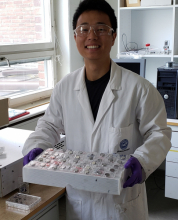
University:
Major:
Site Abroad:
Mentor(s):
Faculty Sponsor(s):
Faculty Sponsor's Department:
Project Title:
Project Description:
Lithium ion batteries store energy through redox reactions. This allows a high energy density, but this mechanism is limited by diffusion of the lithium ions within the cell. Supercapacitors are devices capable of managing high power rates compared to batteries. They store energy through the separation of charges at the surface of electrodes in a double layer. This physical energy storage process is much faster but is able to store much less energy. An asymmetric supercapacitor aims to achieve both high power and energy density by using supercapacitor-type and battery-type electrodes in tandem. For titanium dioxide electrodes to perform well at high galvanostatic cycling rates, material with specific crystallinity and morphology must be synthesized and cast as electrodes. Using organic templates, mesostructured anatase beads of one micron in diameter were synthesized. Then an electrode casting method had to be devised to optimize the adhesion of the active material to the current collector and the morphology of the active material. The powders were thoroughly characterized with XRD. The bead morphology was investigated with SEM to prove the successful synthesis. Furthermore, the casted electrode materials were electrochemically tested with charge-discharge cycling, high rate cycling, and cyclic voltammetry in a half-cell configuration (TiO2 electrode vs Li metal). The effects of rare earth cation dopants on the electrochemical performance of the titanium dioxide was also investigated. Finally, the best performing electrode, paired with an activated carbon electrode, was tested in an asymmetric supercapacitor.
